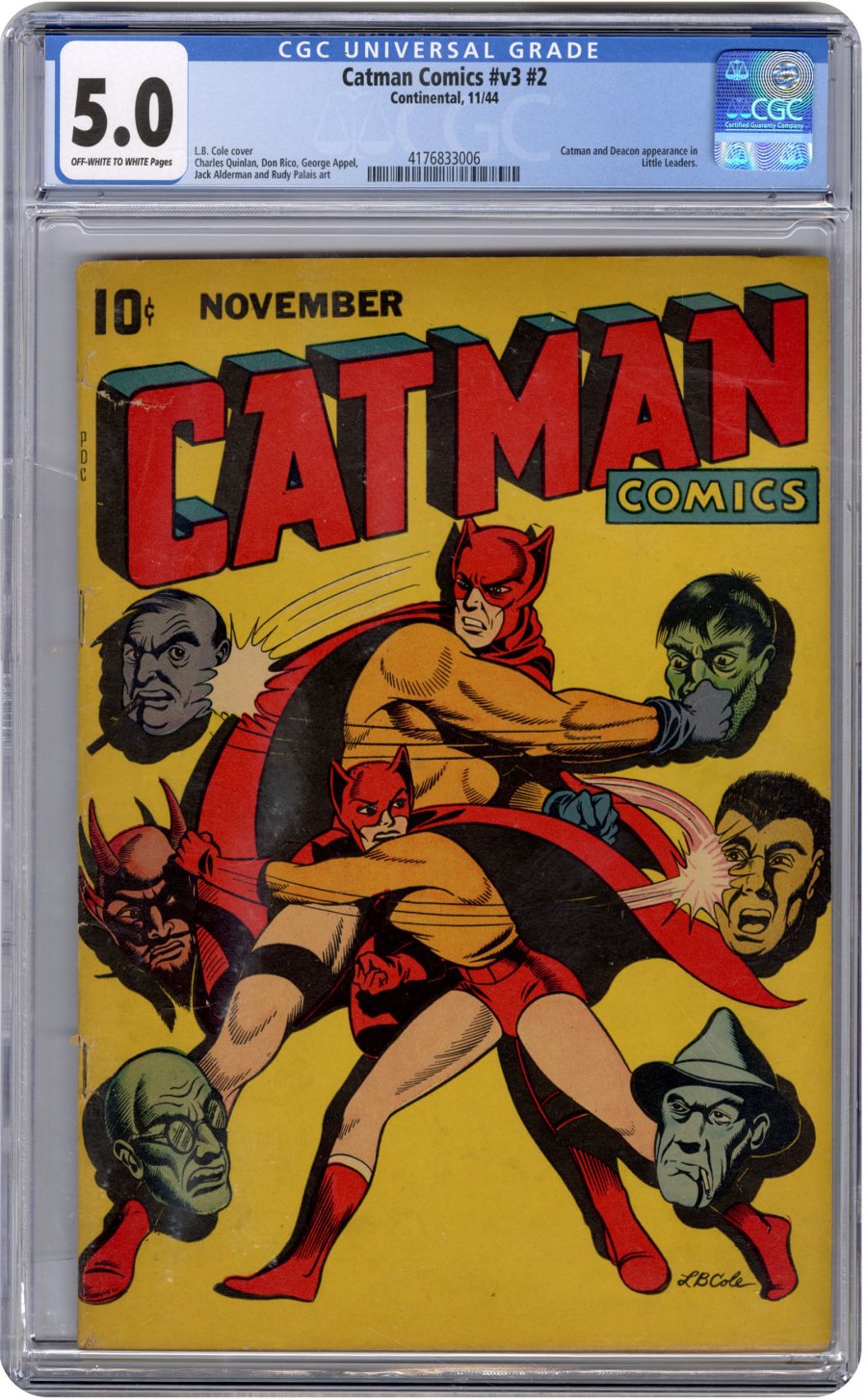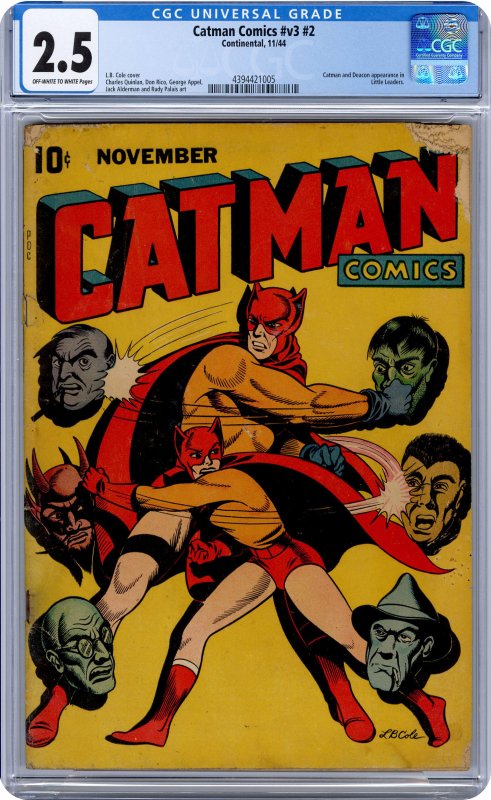CATMAN COMICS (1943-46) V3 #2
CGC VG/F: 5.0

(Stock Image)

START TIME: Monday, 12/02/2024 12:00 PM
Auction Starts In
$1
Starting Bid
--
Bids
(No Reserve)
PUBLISHER: Holyoke
COMMENTS: ow/white pages
L.B. Cole cover; no issue number on cover (Vol. 3, #2)
Read Description ▼
L.B. Cole cover; no issue number on cover (Vol. 3, #2)
DESCRIPTION
ow/white pages
L.B. Cole cover; no issue number on cover (Vol. 3, #2)
The beloved Catman Comics series built a loyal following in the '40s despite a troubled publishing history that often affected the book's distribution. The book only became more scarce as Golden Age collectors discovered the wildly imaginative covers from both Charles Quinlan and (as seen here) the legendary L.B. Cole. This strikingly minimalist art shows Cat-Man and Kitten skipping WWII villains in favor of punching out some gangsters, the Devil, and one character that's seemingly a mad scientist.
This issue is also unique amongst Cat-Man books for going without a number. Officially, it's Nov. 1944's Vol. 3, #2; aka issue #26a. (Publishers would often keep books running under a different numerical order to avoid paying new postal fees to ship a new title.)
Catman Comics was publisher Frank Z. Temerson's attempt to cash in on the sudden superhero boom, resulting in a colorful costumed crimefighter with an origin combining elements of Tarzan, Batman, and Captain America. Catman (aka David Merrywether) originally fought crime as a private detective, and later became a U.S. Army officer. He'd also adopted child acrobat Katie Conn, saving her from a life of crime as she became his sidekick Kitten.
The beloved Axis-bashing hero found a dedicated following despite an often-troubled distribution. (In a unique twist, Catman and Kitten were also the only superhero team who'd age somewhat realistically over the years.) The scarcity of the run, due to that scattered distribution and WWII paper drives, has made Catman Comics one of the toughest and most rewarding Golden Age titles to collect.
L.B. Cole cover; no issue number on cover (Vol. 3, #2)
The beloved Catman Comics series built a loyal following in the '40s despite a troubled publishing history that often affected the book's distribution. The book only became more scarce as Golden Age collectors discovered the wildly imaginative covers from both Charles Quinlan and (as seen here) the legendary L.B. Cole. This strikingly minimalist art shows Cat-Man and Kitten skipping WWII villains in favor of punching out some gangsters, the Devil, and one character that's seemingly a mad scientist.
This issue is also unique amongst Cat-Man books for going without a number. Officially, it's Nov. 1944's Vol. 3, #2; aka issue #26a. (Publishers would often keep books running under a different numerical order to avoid paying new postal fees to ship a new title.)
Catman Comics was publisher Frank Z. Temerson's attempt to cash in on the sudden superhero boom, resulting in a colorful costumed crimefighter with an origin combining elements of Tarzan, Batman, and Captain America. Catman (aka David Merrywether) originally fought crime as a private detective, and later became a U.S. Army officer. He'd also adopted child acrobat Katie Conn, saving her from a life of crime as she became his sidekick Kitten.
The beloved Axis-bashing hero found a dedicated following despite an often-troubled distribution. (In a unique twist, Catman and Kitten were also the only superhero team who'd age somewhat realistically over the years.) The scarcity of the run, due to that scattered distribution and WWII paper drives, has made Catman Comics one of the toughest and most rewarding Golden Age titles to collect.


CATMAN COMICS (1943-46) V3 #2
Holyoke CGC G+: 2.5
A 15% BUYER'S PREMIUM WILL BE ADDED TO THIS ITEM AT CONCLUSION OF THE AUCTION
ow/white pages
L.B. Cole cover; no issue number on cover (Vol. 3, #2)
ow/white pages
L.B. Cole cover; no issue number on cover (Vol. 3, #2)
A 15% BUYER'S PREMIUM WILL BE ADDED TO THIS ITEM AT CONCLUSION OF THE AUCTION
ow/white pages
L.B. Cole cover; no issue number on cover (Vol. 3, #2)
ow/white pages
L.B. Cole cover; no issue number on cover (Vol. 3, #2)
Starting Bid: $1
(No Reserve)
(No Reserve)
Auction Starts In



Life Lines
Life Lines